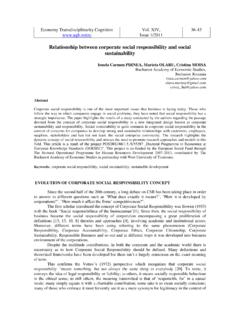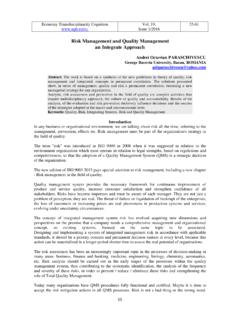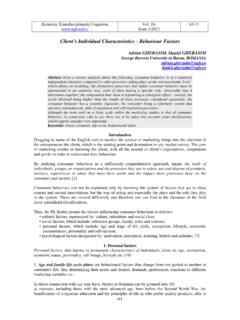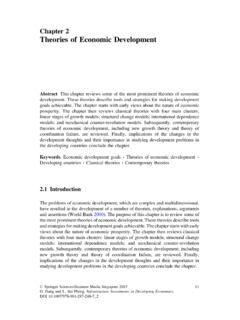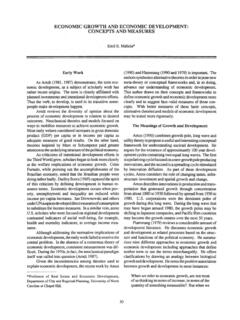Transcription of Concepts of Economic Growth and Development. Challenges …
1 Economy Transdisciplinarity 15, Issue 1/201266-71 Concepts of Economic Growth and Development. Challenges of Crisis and of KnowledgeAlina-Petronela HALLERR omanian Academy Branch of Iasi, Mankind today is crossing a difficult, challenging period. After having crossed several phases of development, going, one by one, through the agricultural and the industrial ones, without abandoning the characteristics of the tradition, nowadays the economy and the society are facing a new stage called the stage of knowledge. The evolutional leap is a remarkable one, but mercantilization generated the start of a deep Economic crisis coupled with two other and even stronger ones, the moral and the spiritual crises. This is the context in which we will refer to two fundamental Economic processes: Economic Growth and : Economic Growth , development, crisis, liberalization AcknowledgementThis paper was made within The Knowledge Based Society Project supported by the Sectoral Operational Programme Human Resources Development (SOP HRD), financed from the European Social Fund and by the Romanian Government under the contract number POSDRU ID Economic Growth and development have been debated for centuries.
2 Industrialization had brought forth permanent changes in the Economic and human activity. After the Depression of the 1929-1933 span, the importance of these processes increases. Overcoming any Economic difficulties, whether we speak about the decreasing of the unemployment rate or about the external equilibrium, a correlation was made with the Economic Growth and development. Any decision made at a state or supra-state level aimed at reaching these two objectives. Today, more than anytime, in a recessionary, liberalized economy, in a world marked by a strong demographic increase, by the depletion of natural resources, by changes of climate and of ecosystem destruction, we are more preoccupied than ever by the problems of Economic Growth and development. Hereinafter will make, an epistemological analysis of these two processes. Economic Growth and Development Conceptual ApproachThough no unanimously accepted definition has been forgotten by now, most of the theoreticians think of the Economic development as a process that generates Economic and social, quantitative and, particularly, qualitative changes, which causes the national economy to cumulatively and durably increase its real national product.
3 In contrast and compared to development, Economic Growth is, in a limited sense, an increase of the national income per capita, and it involves the analysis, especially in quantitative terms, of this process, with a focus on the functional relations between the endogenous variables; in a wider sense, it involves the increase of the GDP, GNP and NI, therefore of the national wealth, including the production capacity, expressed in both absolute and relative size, per capita, encompassing also the structural modifications of economy. We could therefore estimate that Economic Growth is the process of increasing the sizes of national economies, the macro- Economic indications, especially the GDP per capita, in an ascendant but not necessarily linear direction, with positive effects on the Economic -social sector, while development shows us how Growth impacts on the society by increasing the standard of life. Typologically, in one sense and in the other, Economic Growth can be: positive, zero, negative.
4 Positive Economic Growth is recorded when the annual average rhythms of the macro-indicators are 66higher than the average rhythms of Growth of the population. When the annual average rhythms of Growth of the macro- Economic indicators, particularly GDP, are equal to those of the population Growth , we can speak of zero Economic Growth . Negative Economic Growth appears when the rhythms of population Growth are higher than those of the macro- Economic indicators. Economic Growth is a complex, long-run phenomenon, subjected to constraints like: excessive rise of population, limited resources, inadequate infrastructure, inefficient utilization of resources, excessive governmental intervention, institutional and cultural models that make the increase difficult, Growth is obtained by an efficient use of the available resources and by increasing the capacity of production of a country. It facilitates the redistribution of incomes between population and society.
5 The cumulative effects, the small differences of the increase rates, become big for periods of one decade or more. It is easier to redistribute the income in a dynamic, growing society, than in a static are situations when Economic Growth is confounded with Economic fluctuations. The application of expansionist monetary and tax policies could lead to the elimination of recessionary gaps and to increasing the GDP beyond its potential Growth supposes the modification of the potential output, due to the modification of the offer of factors (labour and capital) or of the increase of the productivity of factors (output per input unit).When the rate of Economic Growth is big, the production of goods and services rises and, consequently, unemployment rate decreases, the number of job opportunities rises, as well as the population s standard of economists state that a rate of the GDP Growth of 3% a year allows a rise of the potential GDP with 10% in three years and a doubling in 23 years.
6 According to the rule of 70 , a rate of Growth of 1% doubles the potential GDP over a period of seventy years [2].Other economists think that if the rate of Growth of the real GDP per capita were maintained at 2% a year, then the GDP per capita would double every 35 years and, therefore, each generation could hope for a better standard of life than in the present. Fr this reasons, we should take into consideration the fact that the small differences in the rate of Economic Growth over long periods lead to big differences between the standard of life of the different successive generations. The Economic Growth is also the process that allows the receding of phenomena with a negative Economic and social impact, like unemployment or inflation. But, obviously, a durable Economic Growth sustains human to Leszek Balcerowicz, Economic Growth is a process of quantitative, qualitative and structural changes, with a positive impact on economy and on the population s standard of life, whose tendency follows a continuously ascendant Balcerowicz thinks that the Economic development has four dimensions [3]:-The initial level of development (reflected, for instance, by the income per capita) or the level existing when the rhythm of development starts being determined;-The human capital or the people s level of education and professional training;-The internal Economic condition or the economy s structures;-The external Economic last three factors should be related to the period for which the rhythm of Economic development is determined, which, in its turn, is the result of different interactions between the four groups of factors.
7 The initial level of development is essential for the subsequent rhythm of development. Staying behind involves certain impulses of acceleration the countries with a lower rhythm of development can reach a faster one compared to the richer countries because a state not keeping pace can us at an institutional and technological level the solutions that the developed countries have already found and could learn from their mistakes, an aspect that Balcerowicz deem more important than the former one. 67 The developing countries have an out-of-date Economic structure, most of the population working in fields of low productivity, especially in agriculture, but there are possibilities to transfer resources towards more productive domains. The third factor is characteristic to formerly socialist countries and refers to the disproportion between the relatively high level of education of the population and the possibilities to exploit this training.
8 The high level of education represents an advantage for the countries that joined the Economic development trend. It is also worth pointing out that between Economic Growth and Economic development there are similarities and differences [6]. Similarities refer to the fact that:- Growth and development are continuous processes, with stimulating effects in economy;-Both processes involve the allotment and utilization of resources and the increase of efficiency;-The finality of Growth and development is the improvement of the standard and quality of life;- Growth and development are cause and result of the general trend, influencing its rhythm and ensuring passages from one level to the differences between Economic Growth and development refer to the fact that, while Economic Growth concerns the quantitative side of Economic activity (the increase of results, of quantities, of sizes), development has a larger scope, including qualitative changes that take place in economy and society.
9 In fact, development is a qualitatively higher step of macro- Economic evolution. We often refer to Growth theories when we speak about the developed countries and to the theories of development when we approach the Economic problems that are specific to the developing or less developed countries. A country is able to develop fast when:-industries and people have the possibility to plan their activity on the long run, which requires political, legislative and monetary stability;-the results of Economic activity depend on free initiative, on the efficient utilization of resources, on efficient labour, etc. -investments are not sacrificed in favour of immediate consumption. When most of the current incomes are reinvested, the productive capital increases and, consequently, the real incomes too;-the decisions regarding investments and production are correct, and the wealth accumulated in time is adequately used to achieve assets as efficient as possible from an Economic standpoint;-the degree of education and civilization rises and records a leap forward at the level of consciousness;-any decision takes into consideration the protection and conservation of eco-system (durable development);- Economic , social, spiritual values are Growth and development determine social progress, that is the progressive evolution of the society, which involves an improvement of the human condition, a step higher on the scale of the human being s standard [8], based on Economic progress.
10 The accentuation of the social side of Economic development should not be understood as abandonment of Economic Growth . The Economic achievements create bases for the improvement of the standard of life, for adequate conditions of medical care, for the improvement of the educational system and a better redistribution of incomes in , Economic Growth remains a priority, while the correlation of Economic problems with social ones should lead to the development of any national Economic system, especially when structural crises demonstrate that the limits of the system are about to be final purpose of Economic Growth and development is, undoubtedly, the fulfilment and multilateral development of human personality, the increase of the people s material and spiritual wealth, their stepping higher on the scale of civilization and culture. 68In the General Assembly of the United Nations in September 2000, also known as the Millennium Summit, the status of human development was analysed, considering all its diverse aspects, and a set of eight objectives, with phases and deadlines, was adopted.



